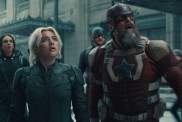
SHOCK talks to cult filmmaker Jeff Lieberman about the 4K restoration of his 1978 classic BLUE SUNSHINE.
Jeff Lieberman may have only directed a handful of horror films but what a handful!
Genre lovers know the New York natives name as the man behind 1976s bizarre killer worm classic SQUIRM (featuring icky FX by a young Rick Baker), 1981s DELIVERANCE meets FRIDAY THE 13th survival slasher JUST BEFORE DAWN and, of course, 1978s damn-near demented LSD addicts turned bald butchers epic BLUE SUNSHINE.
It is the latter film that brings Master Lieberman to Los Angeles next week, where, at the storied Cinefamily theater, he will introduce the new 4K DCP restoration of BLUE SUNSHINE. The action goes down on Friday, November 6th at 10:45pm as part of Cinefamilys Friday Night Frights series. In fact, if you shave your head like the homicidal chrome domes on-screen you get into the screening for free!
But you dont have to bust out the Bic to read the following interview with Lieberman, wherein the no-bullshit filmmaker talks about the restoration of his beloved cult classic in depth.
Have a look
SHOCK: What was the process like to get BLUE SUNSHINE fully restored?
LIEBERMAN: It’s the ultimate ‘found footage’ experience. We literally discovered the original negative in a warehouse, untouched since the release of the movie back in ’78. Before that, it was just written off as lost or more likely destroyed with no hope of ever presenting the movie in its original form. Because the master is so pristine in every way, with no color fading or damage, it was a pretty straight forward scan to 4K. Only routine color correction and dirt removal was required after that to get it back to very close to what it looked like in its original 35mm release.
SHOCK: Did you oversee the scan?
LIEBERMAN: Not every aspect, but I was certainly in on the process. When you’re working in such high definition, all the filmmaking stuff I knew inside out decades ago but haven’t even thought about for so long, came back to play. Like dissolves being ‘opticals’ where it’s another generation down in quality, and the inherent scratches and dirt that get picked up in the optical printers. I’m sure anyone in their 30s or younger who read that line are saying “what the fuck?”
SHOCK: Do you think the 4K enhances the viewing experience?
LIEBERMAN: It’s interesting that I’ve now learned that 4K only kicks in around half way back from the screen in a 300 plus movie house. Anywhere closer, nobody can really discern the difference between 2K and 4K. The same goes for how big you’re going to blow it up. If you projected it at a place like The Music Box in Chicago which is enormous at 900 seats, then the difference would be apparent. But ironically, good old 35mm accomplished the same results, regardless of the size of the theater. It was just a question of the brightness of the projection bulb. Now, for the Blu-ray, it’ll make no difference at all because Blu-ray is 2K. But the key here is that raw file that Blu is made from is scanned for the original negative, not some crappy old print.
SHOCK: All these years later, how do you feel about the film?
LIEBERMAN: It’s funny, I don’t have any direct feelings about any of my films. My entire reality of them plays off other people’s reactions over the years, not to just BLUE SUNSHINE, but my other movies as well. The fact that they’re relevant to a second and even now third generation later is mind boggling to me because I never thought beyond getting a movie finished and out there and then hopefully doing another one. But of the five features I’ve made, SUNSHINE is definitely the most certified ‘cult’ movie, by critics and cinema writers anyway. It’s the one that’s most ‘time stamped’ to represent a very specific time in American culture. University students around the world have actually written papers on it in their sociology and film studies classes. I kid you not!
SHOCK: On that note, the film mirrors the post-hippie generation, but does it have any socio-political relevance today?
LIEBERMAN: I think that every generation has a ‘post’ – meaning post their youth. The vivid thing about the 60s that is unique in American history is the radical break from the previous generations. Every generation rebels and tries new things, but the so called ‘hippie generation’ or ‘baby boomers’ tried to throw the entire past out the window and re-invent everything, based on an idealistic world view with no sense of why the things that came before them happened that way. Then when reality set in, they defaulted to many elements of the previous generation because they existed for sound practical reasons. So I suppose that evolution happens to varying degrees with every generation, but with the 60s being such a radical departure from the past, it made for great fodder for a movie.
SHOCK: What else are you working on these days?
LIEBERMAN: I’m not a policy guy in general, but one thing I’ve learned is there’s no point in talking about stuff until its not only a reality but when I can tell people they can actually see it. So until then, let’s just say I’m slacking









